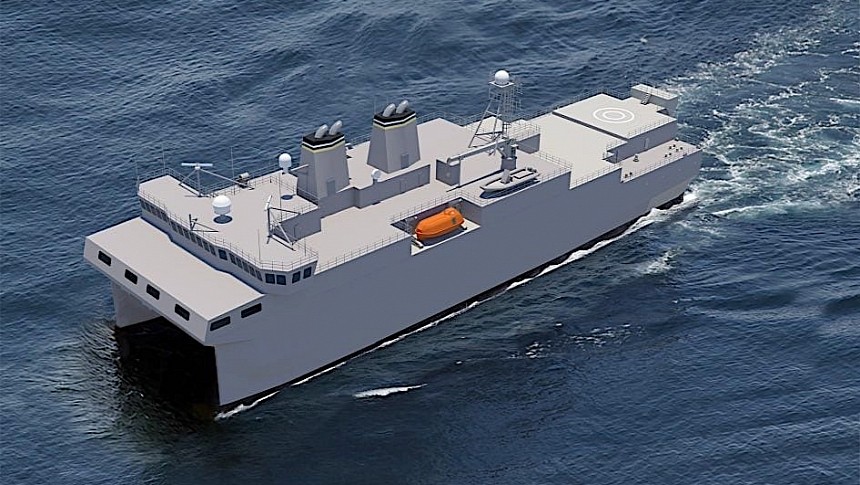All of America's military branches have some kind of impressive modernization program currently being run, but few are as impressive and spectacular as those of the U.S. Navy. After all, we're most of the time talking about programs that will birth floating communities of the warrior kind.
One of the Navy's most ambitious programs is called TAGOS-25. It aims to deliver in the near future a fleet of so-called Auxiliary General Ocean Surveillance Ships that will be used both in the Pacific and the Atlantic oceans to spot enemy submarines.
The ships that will come from this program are referred to as the T-AGOS 25 class, and we're talking about floating pieces of steel hardware measuring 110 meters (361 feet) in length. They are designed like SWATHs (small waterplane area twin hull), meaning a catamaran-like ship.
The program has been in the pipeline for a while now (it was fast-tracked by the Navy last year), but it was only this week that the Defense Department announced it would be a company called Austal that would handle the detailed design and build of the T-AGOS.
Under a contract worth potentially $3,195 billion, Austal will have to build no less than seven such ships, which will eventually be deployed under the United States Military Sealift Command.
These vessels will be used to conduct anti-submarine warfare, more specifically detect and track submarines through both active and passive means. As per the DoD description, they are meant to gather "underwater acoustical data to support the mission of the Integrated Undersea Surveillance System (IUSS) by providing a ship platform capable of theater anti-submarine acoustic passive and active surveillance."
The main tool used for the task is what is known as a Tail. Specialists call the technology Surveillance Towed-Array Sensor System (SURTASS), and it comprises sonars towed behind the ship. It can work regardless of weather conditions.
The first ship to use SURTASS was the USNS Impeccable (T-AGOS-23), which launched in the early 1990s as the sole ship of its class. In its case, the sonar system had a weight of 155 tons, but since then lighter variants have been developed.
Austal will not be alone in working on this mammoth project, with several other big names in the defense and marine industries already involved: L3Harris, Noise Control Engineering, TAI Engineering, and Thoma-Sea Marine Constructors. Austal gave no info on when the first ship of the T-AGOS 25 class could be ready.
The company is no stranger to military contracts, and over the years was responsible for several high-profile military assets, not directly involved in combat, coming to life. The list includes Independence-variant Littoral Combat Ships, Spearhead-class Expeditionary Fast Transports, Navajo-class Towing, Salvage and Rescue (T-ATS) Ships, and Heritage-class Offshore Patrol Cutters.
The ships that will come from this program are referred to as the T-AGOS 25 class, and we're talking about floating pieces of steel hardware measuring 110 meters (361 feet) in length. They are designed like SWATHs (small waterplane area twin hull), meaning a catamaran-like ship.
The program has been in the pipeline for a while now (it was fast-tracked by the Navy last year), but it was only this week that the Defense Department announced it would be a company called Austal that would handle the detailed design and build of the T-AGOS.
Under a contract worth potentially $3,195 billion, Austal will have to build no less than seven such ships, which will eventually be deployed under the United States Military Sealift Command.
These vessels will be used to conduct anti-submarine warfare, more specifically detect and track submarines through both active and passive means. As per the DoD description, they are meant to gather "underwater acoustical data to support the mission of the Integrated Undersea Surveillance System (IUSS) by providing a ship platform capable of theater anti-submarine acoustic passive and active surveillance."
The main tool used for the task is what is known as a Tail. Specialists call the technology Surveillance Towed-Array Sensor System (SURTASS), and it comprises sonars towed behind the ship. It can work regardless of weather conditions.
The first ship to use SURTASS was the USNS Impeccable (T-AGOS-23), which launched in the early 1990s as the sole ship of its class. In its case, the sonar system had a weight of 155 tons, but since then lighter variants have been developed.
Austal will not be alone in working on this mammoth project, with several other big names in the defense and marine industries already involved: L3Harris, Noise Control Engineering, TAI Engineering, and Thoma-Sea Marine Constructors. Austal gave no info on when the first ship of the T-AGOS 25 class could be ready.
The company is no stranger to military contracts, and over the years was responsible for several high-profile military assets, not directly involved in combat, coming to life. The list includes Independence-variant Littoral Combat Ships, Spearhead-class Expeditionary Fast Transports, Navajo-class Towing, Salvage and Rescue (T-ATS) Ships, and Heritage-class Offshore Patrol Cutters.












